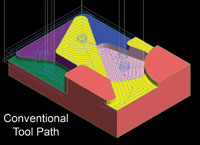by Jim O’Leary
Don’t overlook important elements to optimize machine tool efficiencies
One of the biggest bottlenecks to improved machine efficiencies and profitability is severely limited MRR in material roughing strategies. The biggest driver of limited MRR is preventing end mill breakage by overloading them in transitional movements.
These overload conditions happen in a small percentage of the overall milling toolpath. They typically occur when radial engagement increases as the end mill moves into a corner just before changing directions. The worst case is an abrupt engagement transition from a less than 50 per cent of tool diameter to full radial engagement. This puts tremendous stress on the cutting tool.
The programmer facing these conditions must reduce operating parameters to minimize tool failure by these transitional movements. Overall speeds and feeds, depth of cut and radial engagement are deliberately limited to prevent cutting tool overload and breakage in these transitional movements. Oftentimes, the programmer will use a small diameter insert tool instead of an end mill. He does this under the belief the insert tool is stronger and is more cost efficient than the end mill due to low insert pricing.
 Toolpath techniques for maximum MRR
Toolpath techniques for maximum MRR
CAM software companies recognize the MRR constraints of traditional toolpath methods. They have developed toolpath strategies to overcome the traditional constraints and improve MRR. Collectively, they are called High Efficiency Milling or HEM toolpaths. These new HEM toolpath strategies offer dramatic improvements in the MRR and reduced roughing cycle time. Correctly used, these new roughing toolpath strategies will reduce overall cycle time anywhere from 20 to 60 per cent on the average. They can increase MRR dramatically while protecting the end mill. An algorithm that protects the end mill from overloading in transitions controls the HEM toolpaths. These algorithms keep the end mill constantly loaded in the cut by maintaining the programmed radial engagement. The toolpath does not exceed the specified radial engagement.
 HEM toolpath elements
HEM toolpath elements
- Deep axial depths. Axial cut depths increase to up of four times the tool diameter. This distributes the tool wear over the flute length of the tool. The entire tool wears evenly instead of a short section on the end. This increases tool life by several fold.
- Light radial engagement. Using light radial engagements reduces the cutting pressure on the end mill.
- Increased flute counts. The light radial engagement allows for a higher flute count on the end mill. This will increase MRR while utilizing a higher core strength to minimize end mill deflection.
- Higher spindle speeds. Because the end mill is only engaged to the material for a small percentage of the spindle rotation, the spindle rpm is increased. This will maintain the necessary heat for proper chip plasticization and preventing built up edge. Higher feed rates. The light radial engagement allows the use of chip thinning calculations to help maintain the correct chip load. Typically, a seven per cent tool diameter radial engagement will allow a doubling of the normal feed rate used in slotting.
Learning and aggressively using the HEM technologies in your CAM system will lead to significant improvements in tool life and lower cycle times. The HEM algorithms prevent end mill overload conditions in tool path transitions. This allows the programmer to optimize the toolpath for maximum material removal while protecting the end mill from overload and breakage. HEM roughing tool paths will maximize machine efficiency and improve profitability. SMT
Jim O’Leary is a process improvement specialist with LMT Onsrud.
